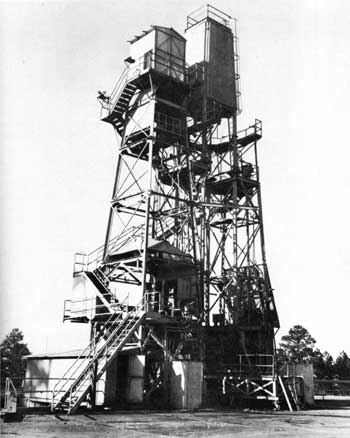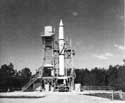.gif)
MENU
|
Man in Space
A National Historic Landmark Theme Study |

|
|
Rocket Engine Test Stands |

Exterior view of Redstone Test Stand, 1961.
(Courtesy of NASA, NASA/Marshall Space Flight Center Facilities Office)
Redstone Test Stand
| Name: | Redstone Test Stand (Interim Test Stand) |
| Location: | George C. Marshall Space Flight Center, Huntsville, Alabama |
| Owner: | National Aeronautics and Space Administration (NASA) |
| Condition: | Excellent, unaltered, original location |
| Builder/Architect: | U.S. Army |
| Dates: | 1953-1961 |
DESCRIPTION
The Redstone test stand is a steel frame structure made from salvaged materials. The stand is 75 feet tall and 33 by 22 feet at its base. There is an external stair and two working platforms. An asbestos-sided gable roofed shed is found at the top of the structure.
The blockhouse for the test stand was used for observations and for receiving telemetered data during the tests. The blockhouse is constructed from three surplus chemical steel tanks covered by a mound of dirt. There are metal doors on the east side of the blockhouse, observation windows, and a roof observation post. The three tanks contain 1,500 square feet of usable space for the test engineers. The initial construction cost of the Redstone test stand in 1953 was $25,000. The Redstone test stand is in excellent physical condition. [1]
STATEMENT OF SIGNIFICANCE
The Redstone test stand is the oldest static firing facility at the Marshall Space Flight Center. It was constructed by the Ordnance Guided Missile Center at Redstone Arsenal and was transferred to NASA in 1960. It was the first test stand in the United States to accommodate the entire launch vehicle for static tests (previous test stands in this country had accommodated the engine only) and was an important facility in developing the Jupiter C and the Mercury-Redstone vehicles that launched the first American satellite and the first American manned spaceflight. The test stand was also used to develop the "manrated" launch procedures vital to manned space flights and the acceptance firing criteria which were made in launch pneumatics, thrust measurement, propellant fuel procedures, and launch ignition procedures during various tests at this facility.
The basic Redstone missile for which the stand was a major test site had its origin in 1950 when the Ordnance Guided Missile Center began study of a 500-mile-range rocket. The Redstone medium range ballistic missile that evolved from a five-year research and development program was 70 inches in diameter and 69 feet long. Its power was rated at 75,000 pounds thrust.
From this test program, other versions of the Redstone evolved, including the Jupiter C and the Mercury/Redstone.
The Jupiter C was the basis for a detailed proposal for an orbiting earth satellite. This proposal designated "A Minimum Satellite Vehicle Based Upon Components Available From Missile Development of the Army Ordnance Corps," was prepared in 1955. It stated that the Army could launch a satellite within a short time using hardware then available.
After the USSR opened the space age, in October 1957, by orbiting Sputnik 1, the Army Redstone team led by Dr. Werner von Braun was directed to attempt a satellite launch. The feat was accomplished on January 31, 1958, by adding a single solid rocket motor as a fourth stage to the Jupiter C and attaching a scientific payload at its forward end.
NASA requested ten Redstones for its first manned program, Mercury. For Mercury, the Redstone propellant tank was lengthened by 6 feet (same as the Jupiter C) and the standard Redstone engine thrust was increased to 78,000 pounds thrust. This vehicle became known as Mercury/Redstone, and nine of them were tested in the Redstone test stand. Two of the Mercury/Redstone vehicles were eventually used to carry men into space. By that time, the space program had grown, and more sophisticated test sites were necessary.
The site was phased out of the active test program in 1961 and all usable equipment removed. [2]
The Redstone test stand was listed on the National Register of Historic Places as being nationally significant in 1976. It was also designated as an Alabama historic engineering landmark in 1979.
FOOTNOTES
1. Draft Historic Properties Report Redstone Arsenal, Alabama with the George C. Marshall Space Flight Center (Silver Spring, Maryland: Building Technology Incorporated, 1983), p. 34.
2. Harry Butowsky et. al., Man in Space Reconnaissance Survey (Denver: Denver Service Center National Park Service, 1981), pp. 60-61.
BIBLIOGRAPHY
Butowsky, Harry A. et.al. Man in Space Reconnaissance Survey. Denver: National Park Service, 1981.
Draft Historic Properties Report Redstone Arsenal, Alabama with the George C. Marshall Space Flight Center. Silver Spring, Maryland: Building Technology Incorporated, 1983.
Floyd, Warner W. "National Register of Historic Places Inventory Redstone Test Stand." Montgomery, Alabama: Alabama Historic Commission, 1976.
Swenson, Loyd S. Jr., Grimwood, James M., and Alexander, Charles C. This New Ocean: A History of Project Mercury. Washington, D.C.: National Aeronautics and Space Administration, 1966.
PHOTOGRAPHS
(click on the above photographs for a more detailed view)
 Top
Top
Last Modified: Mon, Jan 8 2001 10:00:00 am PDT
http://www.cr.nps.gov/history/online_books/butowsky4/space8.htm
![]()



